|
 
COVER
STORY | IN THE NEWS | OPINION | DIRT
TALK OF THE TABLE | THE HUM | CALENDAR
January 19, 2006
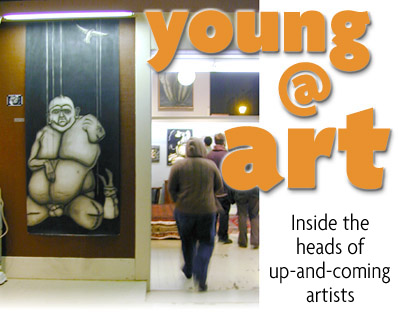
story & photos by HELEN SANDERSON
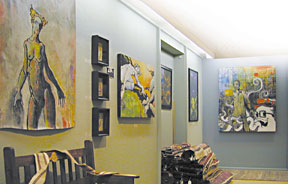 IT'S THE FIRST ARTS
ALIVE! OF 2006 in Eureka, around 7 p.m., and the Humboldt Carpet
Showroom is beginning to fill with people. A young guy with blonde
dreads, or maybe just thick curls, plays guitar and sings the
late 1990s song IT'S THE FIRST ARTS
ALIVE! OF 2006 in Eureka, around 7 p.m., and the Humboldt Carpet
Showroom is beginning to fill with people. A young guy with blonde
dreads, or maybe just thick curls, plays guitar and sings the
late 1990s song
"Sex and Candy" by Marcy Playground.
To his left is another young man in an argyle sweater, keeping
up on a hand drum. The singer's voice is a little raspy but not
tired. He sounds like the lead singer for Rusted Root, purposely
pitchy and kind of eager. And the song, in this acoustic format,
is very Humboldt, very stripped down and earthy and maybe a little
behind the times.
The crowd is on the youngish side. Twenty-somethings
and thirty-somethings in baseball hats and baggy pants mingling,
drinking raspberry punch, scrutinizing the artwork. The colors
are electric. Even the nudes are bright and graffiti-styled.
As the song carries on, a man with dyed red hair
and enormous black pants crawling with zippers and buckles bolts
toward a Forest Stearns painting on the east wall called The
Reach.
"That's f---ing sick!" the guy with the
pants offers to the young woman beside him. She echoes his opinion:
"That's tight."
Done with bright green, orange and gray, The
Reach shows a nude woman stretching her hand toward a man
who falls out of frame. The painting keeps the couple's attention
briefly. Then they move hurriedly down the wall, glancing at
more Stearns' and Dre Meza's artwork, chatting, their heads close
together.
A moment later the young man takes a call on his
cell and stands in the corner with his back to the art.
In the next room two youngish women in jeans and
dressy shoes eye a dark, dominant Dre Meza charcoal piece. It's
a hard one to ignore. The painting is large, seven by three feet,
and the content is somewhat shocking: A naked, rotund amputee
sits on the floor. Strings attached to his penis, head, wrist,
leg and arm rise out of the frame. Beside the figure is a small
bunny. It has the look of a cartoon.
One young woman grabs the other's coat sleeve.
"I need to know what the bunny means!" she hisses,
giggling before moving on.
We wanted to know what it all meant, too. So we
talked with Meza, Stearns and two other young, bold artists about
making their mark, and staying afloat in Humboldt County.


      
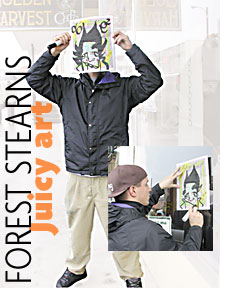 There
are a few reasons that Forest Stearns , 27, is
one of the better-known young artists in Humboldt County. For
one, he's good at what he does, namely grafitti-style paintings
and illustrations. Secondly, he's one of the founding members
of Empire Squared, a sort of renegade collaborative of young
artists who've revitalized the Eureka/Arcata arts scene in recent
years with nervy, fresh installations and impromptu shows. Third,
and maybe most importantly, Stearns is a showman, making art
at public events like Reggae on the River, painting murals and
giving away pieces for free. While studying at HSU he and other
Empire Squared members rattled cages in the art department and
made names for themselves by covering the hallways with their
work. Stearns raised faculty eyebrows by selling paintings he
made in class. The recent graduate talked to the Journal
about what it takes to be an artist. There
are a few reasons that Forest Stearns , 27, is
one of the better-known young artists in Humboldt County. For
one, he's good at what he does, namely grafitti-style paintings
and illustrations. Secondly, he's one of the founding members
of Empire Squared, a sort of renegade collaborative of young
artists who've revitalized the Eureka/Arcata arts scene in recent
years with nervy, fresh installations and impromptu shows. Third,
and maybe most importantly, Stearns is a showman, making art
at public events like Reggae on the River, painting murals and
giving away pieces for free. While studying at HSU he and other
Empire Squared members rattled cages in the art department and
made names for themselves by covering the hallways with their
work. Stearns raised faculty eyebrows by selling paintings he
made in class. The recent graduate talked to the Journal
about what it takes to be an artist.
Describe your artwork.
I try to do multiple styles of art. I think that
if you specialize too much in one style, particularly at my age,
then you burn yourself off. Finding a definitive style right
now would be certain death to me. I try to reach out and touch
on other people's styles and other movements of style and push
myself into doing giant murals where I need one style for, or
graphic design where I need another style for, or street art.
I like my work to be intensely visual. I like the
line quality to be strong and graphic. I like each one of my
pieces to battle. Meaning, like, in the school of graffiti, if
you do a piece and it stands strong next to another piece [on
the wall]. If it stands strong next to another piece, on the
street or in a gallery, it's good. I'm really into electronica
music, like poppy, clicky, organic music and I want my paintings
to look that way.
Tell me about The Reach.
I'm working with a clothing company right now and
we're going to put part of that painting on a T-shirt. I just
got back from Greece, I was there all summer long painting with
the [HSU] program. There were 12 students and every day we would
paint for four hours. We took a model with us. So I dove into
this [nude] series and painted all that stuff there. So this
painting itself was made by pushing and distorting the composition
and even pushing one figure off the page.
Was your style very different from the other
students you traveled with?
Yeah, it's definitely a sharper, bolder style.
I was probably the tightest painter there.
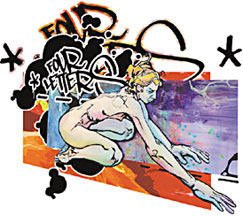 When
you say tight, what do you mean? When
you say tight, what do you mean?
There's nothing really loose about these paintings.
Maybe the backgrounds are loose but the tightness is in the figure,
it's not loosely rendered. The black lines are tight. It's not
an exclamation like -- "tight!" It's tight in the way
you make a cabinet and the joints are tight.
What are you doing now?
For a living I'm painting murals. I'm using my
paintings and doing graphic illustration for Four Letters and
painting murals for people, giant paintings, which I love to
do. And I think just coming out of school at HSU I was really
pushed to paint, traditional paint on canvas. But I like to go
big better than that. I also love to do live art with people.
Why did you get E-squared together?
It's really important to me to have a peer group
because I want to have people to talk to; to talk theory, to
talk philosophy, poetry, have an art show or a Deep Groove electronica
party. It's all a wonderful social experiment. We started E-Squared
with three people and one show and we packed it at Amigas Burritos.
We were a no-name and we packed Amiga's. It was totally rad.
That was show one. I'm almost at 50 shows up here. It started
with three [people], went to five, went to seven, now it's at
16. Without really wanting to or meaning to, people of like minds,
maybe not of like art, sort of hooked on to what we were doing.
Where do you see yourself going with your art?
Where I really see myself wanting to go is to get
my master's degree so I can teach. Being a professor doesn't
intrigue me as much as being constantly surrounded by inspired
peers. I want to be teaching in 50 years and be around students
-- I don't know what kind of style they're going to be using
and it doesn't matter. But I want to be drawing off them and
giving them my juice. And ... I want weekends off, I want summers
off and I want holidays.
Do you want to stay in Humboldt County?
No, I don't like Humboldt County for the weather.
It's an incredible place for the arts and we've developed something
with Empire Squared that hadn't been done. That's because in
this town it's easy to be the big fish in a small pond. There's
less competition here. But I'd like to take my knowledge from
here, go to grad school and become a professor.
Who buys your art?
An interesting range of people. Older people with
money will buy it. People who like juicy expressive art will
buy it. People who like exciting art will buy it. I hate to put
myself in that bracket but it's contemporary and evolving. People
who like the "art of now" are buying it. My peers are
buying it. People who want to use it to further their own image
are buying it -- like the clothing company. I try to price my
paintings so I can make rent, but I also do a lot of street art
because I want people to have access to my art. I have to put
a price on my murals so I can make a living, but I also will
do a hundred free paintings and stick them around town and people
will collect them.
That's my goal, to draw and paint all I want. Sometimes
it's a struggle to put a rent check together at the end of the
month and sometimes it's like, we're all going out to
dinner.
ABOVE: Forest Stearns draws on the back
of a Journal while waiting outside of Morning Star, an
urban clothing store in Arcata where he recently installed a
mural.
"Maximum Exposure:" This Forest Stearns
painting will be printed on T-shirts by clothing company Four
Letters.


      
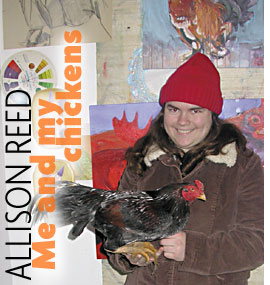 Allison
Reed, 20, lives on the outskirts of Arcata on three acres
along Warren Creek with her folks, her brother, 70 chickens,
25 pigeons, five geese, a duck and a dog, Hobie, who sleeps in
a kennel beneath her raised bunk bed. She learned to paint with
acrylics about five years ago and is currently taking a semester
off from College of the Redwoods to pursue painting in earnest.
Her portraits of shelter dogs are on display at the Accident
Gallery, another collaborative begun by young artists. Eleven
of Reed's pieces sold on opening night; 40 percent of the proceeds
benefited Friends for Life animal rescue. Allison
Reed, 20, lives on the outskirts of Arcata on three acres
along Warren Creek with her folks, her brother, 70 chickens,
25 pigeons, five geese, a duck and a dog, Hobie, who sleeps in
a kennel beneath her raised bunk bed. She learned to paint with
acrylics about five years ago and is currently taking a semester
off from College of the Redwoods to pursue painting in earnest.
Her portraits of shelter dogs are on display at the Accident
Gallery, another collaborative begun by young artists. Eleven
of Reed's pieces sold on opening night; 40 percent of the proceeds
benefited Friends for Life animal rescue.
Where did you learn to paint?
I took intermediate and advanced painting from
HSU during my senior year in [Arcata] high school. My first year
out of high school I went down to Oakland at California College
of the Arts. It was really great down there but it was too expensive
for me. I was basically living off of scholarships and grants
and stuff. I looked at it, and I would be $40,000 or $50,000
in debt if I stayed. So I got out of there and came back up here
and started my chicken project again.
You mean a chicken project not related to art?
Right. My other hobby is raising chickens. I've
been doing it for about 10 years. I take them around the state
and I show them. They're all submission chickens, there's purebreds,
like bantams.
Do you eat them?
We don't eat them but we use their eggs. They're
like purebred show dogs, but in the chicken world. All the weird,
fancy chickens you see at the fair every year, that's what I
have.
What's with the mascot heads? [See
cover image.]
I wanted to see if I could do it. It's kind of
an interesting hobby. I could get some gigs selling them, too.
My friends and I go down to L.A. and buy the materials, the faux
fur in the fashion district. They don't sell that stuff up here.
But it's just kind of a hobby. The art thing is what I want to
do as my career.
The week before Arts Alive! You cranked out
a bunch of paintings for your show at the Accident Gallery. How
many?
I think I did about 25 paintings probably a week
and a half before the show. Then the power went out so I was
painting in the dark. It was a pretty mad rush but I'm happy
with what I made. They're all from photos of shelter dogs. They're
real dogs in shelters around California. Most of them are actually
from L.A. There's just a huge population of dogs that go through
the shelters every day and it's really sad.
I noticed your website. When did you get online?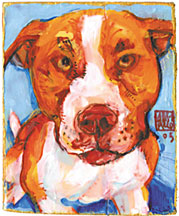
My dad and I got a computer together in 1996 and
got on the Internet and all that. We taught each other how to
build websites. From then on I kept making websites. I basically
had one for me and my chickens for 10 years. I've got my portfolio,
which needs to be updated, I've got a little bio, and I've got
chickens and photos and how to contact me.
Have people contacted you?
Oh yeah. I've sold a lot of work online. People
ask me for pet portrait commissions. But yeah, I get a lot of
traffic through it. People type in "Arcata" and "art"
and my site pops up. I get a lot of random emails. It's really
cool.
Do people from other states contact you?
I've had people from Florida and Georgia contact
me. This one guy in Georgia buys a lot of my work. He buys anything
with a Husky in it.
How much do you charge for a pet portrait?
I usually don't go for under $150. So $150 up for
small portraits and bigger ones are maybe $400 or $500.
What motivates your artwork?
Um, I think it's an addiction. If I don't paint
for a while I feel really unfulfilled. I have to keep drawing.
Seriously, I get depressed when I don't do art so I have to keep
doing it.
Do you feel like you're part of the artist community
around here?
I'm really new to it. I just became a member of
Accident Gallery so I'm still trying to fit in with all that.
I kind of feel out of place because I'm so independent. I don't
really have any artist friends that I go hang out with or anything
yet. I paint on my own most of the time. But I think artist groups
like that are really great. Like, the Accident Gallery is wonderful.
I'm starting to get to know the guys there and they're great
people. They taught me how to silk screen and they taught me
all this stuff.
Do you see yourself staying in Humboldt County?
Um, I don't know. I'll probably eventually move
away because the market up here is not that great. You have to
sell your paintings for a hundred bucks, and you'll sell lots
of them at a hundred bucks but once you go up more than $800
or $900 buyers shy away. At least that's what I've found. I've
been going to shows for a couple years and you rarely see work
that sells over a thousand bucks. At the Accident Gallery you
never see it.
ABOVE: Allison Reed shows off
her aseel chicken, an Asian breed that inspires some of her paintings.
A pit bull painting by Reed on display at Accident
Gallery.


      
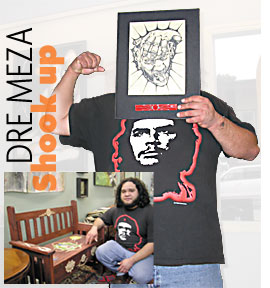 They
say you can't judge a book by its cover, and it seems to be true
of the art scene here. On the surface everyone seems to be getting
along, but underneath there's some tension. We've picked up hints
of it lately, but Dre Meza, 29, painted a clearer picture
of gallery in-fighting in Old Town and how it's reflected in
his art. They
say you can't judge a book by its cover, and it seems to be true
of the art scene here. On the surface everyone seems to be getting
along, but underneath there's some tension. We've picked up hints
of it lately, but Dre Meza, 29, painted a clearer picture
of gallery in-fighting in Old Town and how it's reflected in
his art.
How would you describe your artwork?
I've never heard anyone say, "Oh, your art
looks like so and so's." It depends what kind of influence
I'm around. For Christmas I got books on Brazilian graffiti and
stuff from Africa and all these styles that are so much different
from the stuff we've got going on around here.
Are you in with Empire Squared?
No, not yet. I was wondering if you were going
to ask. I was with the Accident Gallery. I started that [Accident
Gallery]; me and some other people, we started that two
years ago, maybe. I recently stepped away from that because I
didn't like where it was going. They're going in a very backward
direction from where we started and why we did the whole thing.
What's different at Accident Gallery now?
It just lost the feel of art. Everyone's doing
what sells and what sells is not necessarily what they do. I
don't think people should change themselves for money. We came
into it as artists that no one would give a chance to. No one
would look at us so we said, when we get our own place we're
gonna let people in who have a hard time getting shows and we're
going to do this for artists, not for money. Now I've seen them
turn away a lot of people, put their nose up to people and it
bothers me when I remember when we started --we got a lot of
that and we hated it.
Tell me about the large piece, the one with
the nude, amputated man, that was up for Arts Alive! at the Showroom.
It's really bold. What inspired it?
That was my farewell piece to the Accident Gallery.
I was expressing the way I felt. That piece probably has more
of me in it than any other piece I've ever done. All my charcoal
pieces have a little bit of me in it because after rubbing in
charcoal your hands will bleed so it has blood and sweat and
love in it. But that one was a lot of emotion. Everything means
something, the strings, the bird, the nakedness, the caked on
make-up -- it's like him trying to hide himself from what he
really is and denying what's really going on. The strings are
like the control someone else has but it's also about breaking
free eventually. The bird was kind of a symbol of false hope.
It's a dove and people think that is a peaceful symbol of good
things to come but it's actually just a messenger of death.
What about the bunny? [See
title image.]
The bunny's like a sense of false comfort, like
money. It's there but you can't really hold it. It's close, it
kind of makes you feel good, like everything's gonna be alright,
it's your little comfort blanket but at the same time it's not
tangible.
What are you working on now?
Right now, just tattooing [part-time at Wicked
Images in Eureka]. I don't have any shows around here very soon.
I have a show coming up in San Francisco in about a month and
a half. I'm going to use some of my older stuff for that; they
requested a few.
Do you sell art? Does art pay the bills?
No, I work. I wish art did [pay the bills], but
it's never been about money. I have high prices on stuff and
I think I do that because I'm hoping nobody buys it.
I work for HCAR [the Humboldt Community Access
& Resource Center] right now. I've been doing that for about
five years and I probably always will. I can't imagine not doing
that. No, art doesn't really pay the bills. It costs me more
than anything. But I love it. I can't be without it.
You've done Latino-themed art exhibitions at
the Ink People. How does your cultural identity influence your
artwork?
Oh, man. For the past couple of years I've been
trying to get more in touch with my roots and my Mexican side.
I'm Mexican but I barely speak Spanish. My family, my mother,
she speaks it but she never taught it. So I've been trying to
get more in touch through art and taking Spanish classes from
a friend of mine. The art side of it, I love it. I don't know
what everything means, like the Aztec symbols, but I take the
ones that sort of strike a feeling and use them. I've done a
couple just out of my own head and it's strange how much your
culture gets in your veins: When I look in books I see symbols
that are almost exact as things I thought I made up.
What message are you trying to convey in your
art?
I guess it's just to be true to what you do. I
see a lot of people do art that's not them. You've got to do
it because you love it, not because you're going to get rich.
At the shows, it's the peoples' reactions and the compliments.
With one piece, when it was up at the Accident
Gallery, there was a guy who just stood in front of it for like
an hour and a half just crying. He had never seen art that shook
him that bad. They had some vote there that night for what piece
of art was the best. And I was like, you guys can do whatever
you want with that superficial crap, I had a person who was moved
right down here [points to his heart] and that's worth
more than any of your votes. If my work makes a difference to
one person that's all it takes. I told that guy that he made
everything I've done in the last couple of years worthwhile,
just in that one moment of meeting him.
ABOVE: Dre Meza, right, poses with Self
Preservation an ink-injected design on synthetic skin, a practice
material for tattoo artists. Above, Meza beside a carved bench.
Below, nudes by Stearns, including The Reach, center. Framed
art by Meza.


      
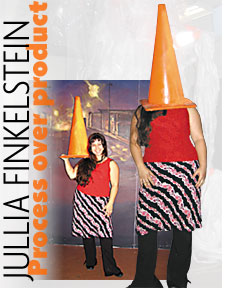 Jullia
Finkelstein, 26, is working toward her teaching credential
at Humboldt State University and is currently an art instructor
at the Arcata Art Institute at Arcata High. She moved to Humboldt
County in 1998 to study biology at HSU and a year later began
studying art. In November she exhibited an installation called
Woven Road of Rumination at the Empire Squared
gallery. The show used asphalt, woven plastics, cones, road signs
and other Caltrans paraphernalia, forming a spiral road and pseudo-construction
site. A San Francisco gallery, Million Fishes, is planning to
show Rumination. Finkelstein is an Empire Squared member
and the daughter of artists. Jullia
Finkelstein, 26, is working toward her teaching credential
at Humboldt State University and is currently an art instructor
at the Arcata Art Institute at Arcata High. She moved to Humboldt
County in 1998 to study biology at HSU and a year later began
studying art. In November she exhibited an installation called
Woven Road of Rumination at the Empire Squared
gallery. The show used asphalt, woven plastics, cones, road signs
and other Caltrans paraphernalia, forming a spiral road and pseudo-construction
site. A San Francisco gallery, Million Fishes, is planning to
show Rumination. Finkelstein is an Empire Squared member
and the daughter of artists.
How would you describe your artwork?
I feel like I'm a really process-oriented artist
and all the work that was in my show, Woven Road of Rumination,
came out of me spending a lot of time in the process
and my personal relationship with the materials. I'm interested
in working harmoniously with my environment and a lot of my artwork
examines degradation and environmental impact. I started kind
of examining the materials not only that I use in my own life
but within the lives of others that have created hazardous impacts
but also positive impacts.
I've been really obsessed with plastics; that's
what I've been using in my art. For myself I'm not necessarily
making a statement as to whether it's a good or bad thing. My
art for me is meditative and reflective, it's a process of examining
without necessarily making judgments. I hope to encourage other
people to examine their own practices.
Do you ever fear that the message is lost?
I was actually blown away opening night by the
reception and curious intrigue people had and I know from talking
with people in the community that there was a lot of discussion
to it. So it's encouraging to me to run into people that saw
my show who say, "Are you the girl who wove a labyrinth
out of plastic?" So there has been a lot of affirmation.
But there were times when I said, "Why am
I doing this?" I probably spent 500 hours on that show just
to be up for one night. But I think that was the way it was actually
more powerful because it became a happening, it became a moment,
an experience that only happened once. It's like giving birth.
People told me, you just gave birth to this exhibit.
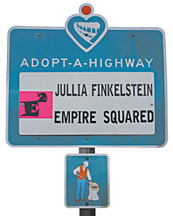 Right, it's unpaid
labor. Was it a concern, that you were making art you couldn't
sell? Right, it's unpaid
labor. Was it a concern, that you were making art you couldn't
sell?
It was intentional. For it to be a happening I
didn't want a monetary value attached to that because my intention
was in the spirit of the process not the spirit of the product.
I wanted it to be about a construct.
You're working full-time as an instructor at
the Arcata Arts Institute at Arcata High. Tell me about the program.
I'm currently in the credential program at Humboldt
State University, and my mentor teacher at this time is Anne
Bown-Crawford who is the head of the art department at Arcata
High and she's responsible for starting the Arts Institute, which
is in its second year. I've been working with her in incorporating
Empire Squared members in for workshops.
What trends are your students interested in?
Graffiti. It's new to Arcata. They're interested
in figure drawing, developing characters, graffiti characters.
That's the type of graffiti they're interested in, and I think
that's a sign of popular trends in art.
Is Humboldt County a good place for artists?
Yes and no. We're hidden here behind the Redwood
Curtain. It's good in a sense that we're building a community
and there is a stronghold of youth working with contemporary
ideas. And at the same time, it's a bubble. We have a strong
network here, but you have to travel 250 miles to bump into another
network. So there is a lot of support but there isn't a lot of
exposure to new things. At the same time the Internet has made
a lot possible.
Do you see yourself in Humboldt County long
term?
Possibly. I feel like I'm in a hallway with a bunch
of doors and I'm not quite sure which one I want to open yet.
I'm really hungry to go to Mexico and I'm really hungry to move
to San Francisco. I'm definitely not going stay here without
leaving for a while.
ABOVE: Finkelstein incorporated more
than 70 cones in her recent Empire Squared art installation,
Woven Road of Rumination. Behind her is a mural depicting the
industrial edge of Old Town, outside of the E-Squared gallery
on Third Street, Eureka.
Finkelstein adopted a stretch of Highway 101
north of Arcata. Her Art Institute students helped collect the
trash and used it in their art projects.


      
TOP
COVER
STORY | IN THE NEWS | OPINION | DIRT
TALK OF THE TABLE | THE HUM | CALENDAR
Comments? Write a
letter!

© Copyright 2006, North Coast Journal,
Inc.
|


 IT'S THE FIRST ARTS
ALIVE! OF 2006 in Eureka, around 7 p.m., and the Humboldt Carpet
Showroom is beginning to fill with people. A young guy with blonde
dreads, or maybe just thick curls, plays guitar and sings the
late 1990s song
IT'S THE FIRST ARTS
ALIVE! OF 2006 in Eureka, around 7 p.m., and the Humboldt Carpet
Showroom is beginning to fill with people. A young guy with blonde
dreads, or maybe just thick curls, plays guitar and sings the
late 1990s song
 There
are a few reasons that Forest Stearns , 27, is
one of the better-known young artists in Humboldt County. For
one, he's good at what he does, namely grafitti-style paintings
and illustrations. Secondly, he's one of the founding members
of Empire Squared, a sort of renegade collaborative of young
artists who've revitalized the Eureka/Arcata arts scene in recent
years with nervy, fresh installations and impromptu shows. Third,
and maybe most importantly, Stearns is a showman, making art
at public events like Reggae on the River, painting murals and
giving away pieces for free. While studying at HSU he and other
Empire Squared members rattled cages in the art department and
made names for themselves by covering the hallways with their
work. Stearns raised faculty eyebrows by selling paintings he
made in class. The recent graduate talked to the Journal
about what it takes to be an artist.
There
are a few reasons that Forest Stearns , 27, is
one of the better-known young artists in Humboldt County. For
one, he's good at what he does, namely grafitti-style paintings
and illustrations. Secondly, he's one of the founding members
of Empire Squared, a sort of renegade collaborative of young
artists who've revitalized the Eureka/Arcata arts scene in recent
years with nervy, fresh installations and impromptu shows. Third,
and maybe most importantly, Stearns is a showman, making art
at public events like Reggae on the River, painting murals and
giving away pieces for free. While studying at HSU he and other
Empire Squared members rattled cages in the art department and
made names for themselves by covering the hallways with their
work. Stearns raised faculty eyebrows by selling paintings he
made in class. The recent graduate talked to the Journal
about what it takes to be an artist. When
you say tight, what do you mean?
When
you say tight, what do you mean? Allison
Reed, 20, lives on the outskirts of Arcata on three acres
along Warren Creek with her folks, her brother, 70 chickens,
25 pigeons, five geese, a duck and a dog, Hobie, who sleeps in
a kennel beneath her raised bunk bed. She learned to paint with
acrylics about five years ago and is currently taking a semester
off from College of the Redwoods to pursue painting in earnest.
Her portraits of shelter dogs are on display at the Accident
Gallery, another collaborative begun by young artists. Eleven
of Reed's pieces sold on opening night; 40 percent of the proceeds
benefited Friends for Life animal rescue.
Allison
Reed, 20, lives on the outskirts of Arcata on three acres
along Warren Creek with her folks, her brother, 70 chickens,
25 pigeons, five geese, a duck and a dog, Hobie, who sleeps in
a kennel beneath her raised bunk bed. She learned to paint with
acrylics about five years ago and is currently taking a semester
off from College of the Redwoods to pursue painting in earnest.
Her portraits of shelter dogs are on display at the Accident
Gallery, another collaborative begun by young artists. Eleven
of Reed's pieces sold on opening night; 40 percent of the proceeds
benefited Friends for Life animal rescue.
 They
say you can't judge a book by its cover, and it seems to be true
of the art scene here. On the surface everyone seems to be getting
along, but underneath there's some tension. We've picked up hints
of it lately, but Dre Meza, 29, painted a clearer picture
of gallery in-fighting in Old Town and how it's reflected in
his art.
They
say you can't judge a book by its cover, and it seems to be true
of the art scene here. On the surface everyone seems to be getting
along, but underneath there's some tension. We've picked up hints
of it lately, but Dre Meza, 29, painted a clearer picture
of gallery in-fighting in Old Town and how it's reflected in
his art. Jullia
Finkelstein, 26, is working toward her teaching credential
at Humboldt State University and is currently an art instructor
at the Arcata Art Institute at Arcata High. She moved to Humboldt
County in 1998 to study biology at HSU and a year later began
studying art. In November she exhibited an installation called
Woven Road of Rumination at the Empire Squared
gallery. The show used asphalt, woven plastics, cones, road signs
and other Caltrans paraphernalia, forming a spiral road and pseudo-construction
site. A San Francisco gallery, Million Fishes, is planning to
show Rumination. Finkelstein is an Empire Squared member
and the daughter of artists.
Jullia
Finkelstein, 26, is working toward her teaching credential
at Humboldt State University and is currently an art instructor
at the Arcata Art Institute at Arcata High. She moved to Humboldt
County in 1998 to study biology at HSU and a year later began
studying art. In November she exhibited an installation called
Woven Road of Rumination at the Empire Squared
gallery. The show used asphalt, woven plastics, cones, road signs
and other Caltrans paraphernalia, forming a spiral road and pseudo-construction
site. A San Francisco gallery, Million Fishes, is planning to
show Rumination. Finkelstein is an Empire Squared member
and the daughter of artists. Right, it's unpaid
labor. Was it a concern, that you were making art you couldn't
sell?
Right, it's unpaid
labor. Was it a concern, that you were making art you couldn't
sell?